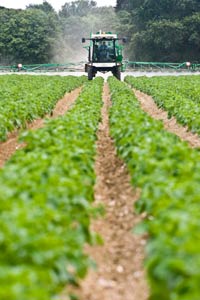Off-label pesticide use increasing as industry loses products

Products receiving a specific off-label approval for use in combinable crops, such as beans and oilseed rape, are helping mitigate the loss of key pesticides.
David Martindale, an independent agronomist from Arable Alliance in Yorkshire, says: “They’re no longer being used just in horticultural and vegetable crops.”
So what are they, how are they obtained and what do growers need to do to take advantage of this increasingly important tool?
What is an SOLA?It is intended for use against a specific pest, weed or disease problem on a named crop that is not on the product label. They are applied at the “grower’s own risk”, while meeting safety requests.
Any SOLA approvals granted may have additional conditions of use attached to them. Use in these cases is undertaken at the user’s choosing and the commercial risk is entirely with the grower.
Who can apply for a SOLA licence?Paul Chambers, the NFU’s plant health adviser, says any grower can apply for a SOLA, but grower groups or organisations like the Horticultural Development Company are most successful in getting an approval.
“An application often occurs when commercial reasons prevent a manufacturer from applying for a full product approval,” he explains.
“This requires full data submission, for example, additional efficacy data – and hence there’s a much higher cost.”
However, to get a SOLA, the application needs to address all safety aspects of the risk of the proposed off-label use with data and/or a reasoned specific case.
“The reasoned specific case could be that the crop product is already approved in another EU Member State where growing conditions are similar,” he adds.
The application fee is fixed by the Chemicals Regulation Directorate (CRD) and is currently around £1200, he says.
What documentation do I need before using a SOLA?
z The grower must have a copy of the notice of approval SOLA document. Electronic copies can be obtained from the CRD website (www.pesticides.gov.uk/offlabels), which includes a specific section on the use of SOLAs.
It is essential that growers obtain a copy of the SOLA when it is recommended by an agronomist, so they can check it as the guidelines will not be on the label.
“The problem is that SOLAs change, and approvals can be lost,” he adds.
Where are SOLAs being used and what for?A SOLA can offer a different mode of action in the battle against grassweeds, particularly after an essential active ingredient has been withdrawn, Mr Martindale says.
“Defy has a SOLA for use in winter and spring beans and it can be a good starting point for blackgrass control,” he points out.
“There’s also a SOLA for it to be used on spring barley, which can be particularly useful due to limited post-emergence blackgrass control options.”
Other examples include Stomp for use in beans and Fox for cranesbill control in oilseed rape, he adds.
Mr Chambers points out that SOLAs are particularly valuable when there are only a few options available to control specific problem weeds. “Avadex and bifenox are important for use on oilseed rape because there are so few remaining herbicide options for rape,” he notes.
In seed potatoes, there is a SOLA for fluazinam used for powdery scab control, as well as one for rhizoctonia control with Rizolex Flowable.
There are currently no SOLAs for use in winter wheat, notes Mr Chambers. However, growers should note that the use of chlorotoluron (CTU) in spring cereals for annual meadowgrass control is due to expire next spring.
What future areas could SOLAs address?“Many growers face a constant battle with blackgrass and it would be good to have SOLAs introduced to control it in some of the minor crops, like triticale,” says Mr Martindale.

